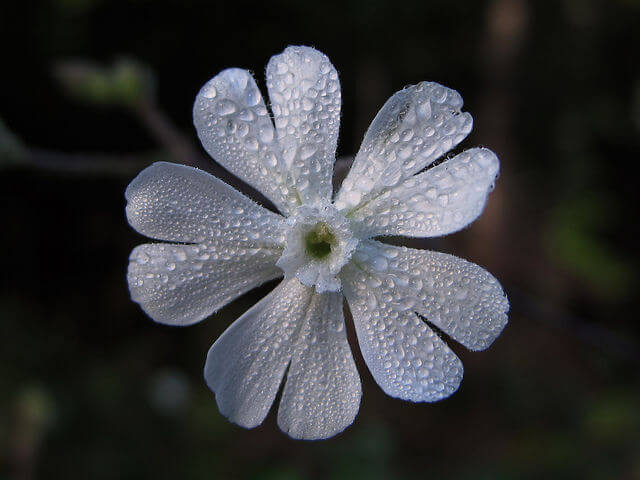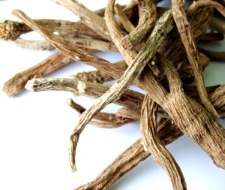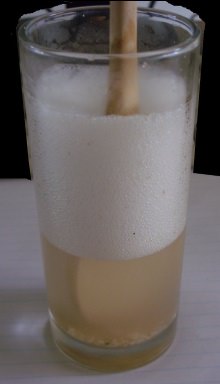Silene Capensis: The African Dream Herb

Silene Capensis has been used for millennia by the Xhosa shaman of the river valleys in the eastern cape of South Africa, where it is known as Undela Ziimhlophe or 'white paths'. It's fragrant white flowers open only at night, when they emit a fragrant and almost hypnotising aroma.
Also known as African Dream Herb or Ubulawu, Silene Capensis induces spectacularly vivid dreams - yet has never entered the mainstream and remains a fringe taste within western culture.
This article looks into what we know about the traditional usage of the African dream herb, what effects it has on the mind and body and how you can best make usage of it to enhance your dreams.
So, What’s The Research On Silene Capensis?
Let’s start with the scientific facts.
Much of what we know about Silene Capensis and the role it plays within the cultures of the African tribes that use it, comes from the research of Manton Hirst and Jean-Francois Sobieki.
These intrepid explorers both spent years living closely with the Xhosa people and reported in detail on their culture and religious practices.
However, given its still relatively obscure status, silene capensis has not been the subject of much formal scientific research at all.
The most exciting development is this 2013 study which attempted to find the physiological mechanism behind the African dream root’s ability to induce unusual dream states. Although this study seems to have had serious funding shortages, it did manage to provide a pretty feasible hypothesis that saponids are the actor behind the root's effects.
This would actually class silene capensis as an ‘AChEI inhibitor’ - putting it in the same category as galantamine and huperzine-A, both of which have become popular commercial lucid dreaming aids in the last decade.
And The Traditional Use Of This African Dream Herb?
First of all, it’s a misnomer to call silene capensis a ‘herb’ at all, since the psychoactive components are contained in the roots of what is a flowering plant.
Now, to understand the dream root, you need to understand that dreaming is deeply embedded into Xhosa culture. Dreams are seen as gifts or messages from the ancestors – who are characterised as drifting ‘white winds’ or ghosts. The ancestors – via dreams - may impart healing guidance or knowledge to their descendents

Silene Capensis is just one of more than 300 psychoactive herbs and plants that the Xhosa use for medicinal purposes. Yet, it is one of the most powerful and is considered sacred - due to its intense dream inducing effects.
The dream root is consumed as part of various ceremonies – including the traditional Xhosa mortuary ritual.
An ox is rubbed with the frothy silene capensis mixture and then slaughtered, before being sprinkled with bile from its own gall bladder. Before tucking into this tasty treat, the Xhosa have an entrée of frothy dream root mixture.
Other ceremonies include a 3-day bender carried out during a full moon. During this religious experience, the initiates consume and even wash themselves with the foamy dregs of the silence capensis mixture. The object appears to be to consume or imbibe as much dream root essence as humanly possible. During this 3 day seclusion, initiates abstain from meat, alcohol and sex. The result - understandably – is an incredible marathon of intense and symbolic dreams.
In fact, Ubulawu is also widely used by Xhosa shaman as a healing agent, including the treatment of mental disturbances and memory improvement. Its cathartic vomit inducing response is also considered valuable – for physical and mental ‘purging’.
The Effects of Silene Capensis
The effects of S. capensis usually manifest during sleep as prophetic lucid dream states that are rich with significance. Individuals do not usually encounter any effects when awake, although there was one report of someone perceiving wavy lines of light in the air about twenty minutes after consuming the root. The dream state is often compared to going under water by the Xhosa.
Your dreams will become exceptionally colourful, and you will remember them vividly on awakening. To sum up the shamanic advice: If you focus on a question you want answered first, the answer will come to you in your dreams – from the wisdom of the ancestors.
In Xhosa culture, the ‘ancestors’ are generally regarded as the paternal grandfather or great-grandfather. So, if you fix these people in your mind, you may receive some passed down wisdom.
To really understand though, let’s look at 4 silence capensis experiences taken from erowid.org
The dream I saw was very strange in nature and was about an intelligent cat that had symbiotic parasites living in its body, some kind of worms made of a metallic substance were eating his flesh and transforming it to something else. The cat took out one of the parasites and dropped it to the ground and it transformed into a lizard, the parasites were some strange mean of creation/metamorphosis which the cat used as a medium to transform it body to something else. Colours in this dream were metallic and VERY bright, like DMT. There were kaleidoscopic spinning backgrounds and many forms including the lizard were extremely sharp and crystalline.
From none of the 60 psychoactive substances that I have tried, have I ever seen such colours. No other substances were taken except black tea.
-- Hum, via erowid
I dreamt that my brother and I were living in a video game based loosely on a scenario in which Imperial Japan rules the world. There are different races, all based on colors. The red-tinted people are the ruling caste. I work for the government, but I'm slowly finding out that I don't like what they're up to and am planning to rebel. The princess is some sort of whimsical mad scientist up to no good. Every time something makes me angry, I acquire this mana-like energy that I can store up and then use to do things like gain advantages in battles, calm myself, and uncover secret passageways and cheat codes. Somewhere along the line, I discover a painting of a person that is aging before my eyes.
-- Yex, via erowid
The dreams that this plant induces are vivid, long lasting, and seem to involve massive journeys. Before I woke up I was running effortlessly from metro station to metro station in some sort of strange race. I never got tired, and I was surrounded by powerful images - massive buildings of glass that towered above the landscape, important notes left on tombstones in a cemetery, and above all a journey that I had to finish that drove me forward from one place of the mind to the next.
The dreams are actually pretty awesome.
-- Electric Shamen, via erowid
OK. So a little while ago I ordered some Silene Capensis, from an Internet vendor. I was interested in lucid dreaming at the time and thought I would give it a shot. I ordered 14 grams of 'Silene Capensis Whole Root'. I prepared this root by breaking up the root into very small pieces. I then got a water bottle and filled it up with water, approximately half full. I put the root with the water and let it sit in the fridge overnight.
The next morning I shook up the water bottle, until lots of foam was produced. I drank almost all the foam, waited an hour and ate breakfast.
That night I went to bed around 2 a.m. I had the most intense, lucid dream of my life. This in fact was my first lucid dream. I remember every detail of the dream, and it was very vivid. I am surely going to try this amazing root again.
-- Tshamany, via erowid
Where to get hold of it?

Silene Capensis is currently legal in every country in the world - and this status doesn’t look about to change any time soon!
Buying silene capensis is not therefore a major challenge.
Availability and quality however does tend to fluctuate. At the time of writing, you can get chopped whole root pieces from Waking Herbs - our recommended supplier.
Preparation of Silene Capensis
Reports online tell us that a wide variety of different approaches have been taken to consuming the dream root. Feel free to experiment - within reason - to find what works best in your circumstances
However as with most things in life, I like to revert to the traditional method of preparation. Why mess with something that has been developed and refined over thousands of years?
We are trying to experience an aspect of ancient African culture, so go to it in the way they do. The other side of the coin of course, is that we don’t have access to the exact methods and subtle recipes that the Xhosa themselves use – so we might feel justified in experimenting to simply try to get as much of the psychoactive chemicals into our blood stream as possible.
Although the usage and preparation of Ubulawu varies among ethnic groups, bear in the mind that the traditional preparation includes intentional vomiting, or purging (much like ayahuasca), which you may or may not wish to follow through with.
The hard version:
The term ubulawu refers mostly to the roots of a variety of herbs and creepers, and sometimes the stems or bark of certain plants (Hirst 1990) that are ground and made into a cold water infusion that is churned with a forked stick to produce foam. This foam production is typical of ubulawu preparations. Ubulawu species are classified by Xhosa diviners according to the locality in which they grow, that is, ubulawu of the river, ubulawu of the forest etc. (Hirst 1990).
Ubulawu preparations, used in the initiation of Southern Bantu diviners, are typically drunk as an infusion until the initiate’s stomach is full and he or she is ready to vomit. Vomiting is then induced. The vomiting of this compound is referred to as ukugabha.
The foam from the preparation is used to wash the body, normally late in the evening (Lamla 1975). Both vomiting and washing with the foam are used “to remove ritual impurity” (Hirst 2005). Though vomiting is reported as removing ritual impurity, the mechanism of vomiting has a physiological affect on the dreaming process that is elaborated on later in this article. The Ubulawu foam is also eaten by initiates on an empty stomach to enhance dreaming. The eating of the foam and the drinking of the infusion prior to vomiting are the means by which psychoactive chemicals in the plants enter the body system, thereby having psychoactive effects, including changes in mood and enhanced dreaming. Thus, both the eating of the foam and drinking and vomiting with the Ubulawu infusion aid the dreaming process through different yet complementary mechanisms. Vomiting is usually performed in the mornings, with the foam being eaten in the evening before sleeping (Mrs. Maponya, personal communication). Yet eating the foam can also be performed both in the morning and evening as occurs with the Xhosa in the Eastern Cape (Broster 1981).The differences in administration of Ubulawu depend on the cultural group in question, with “the Zulu liking to vomit while the Sotho likes to eat the foam instead”
--- Jean-Francois Sobieki 2012
The easy version:

- Purchase some powdered Silene capensis roots (if you buy whole dried roots, you have to powder them yourself – which could be tricky)
- Put a tablespoon of powder into a litre or so of water (perhaps try letting it soak for a few hours or days)
- Stir it hard with a fork (the fork represents your connection to your paternal and material ancestors) until a thick layer of foam is produced on top
- Drink the foam in the morning on an empty stomach until you feel bloated and almost ready to vomit.
- Maybe try some more in the evening.
- Repeat this every day for a course of a few days (or weeks) until you notice the effects
Some users report success making a silene capensis tea. If you want to give this method a try. Simply stir the powder or chopped roots into boiling water and allow to cool.
In Xhosa culture, diviners are also known to chew the silene capensis roots. Why not give it a try?
Silene Capensis Side Effects
I haven’t come across any reports of serious side effects from silene capensis. There are quite a few reports of vomiting, although this is expected if you read the report above.
Final Thoughts
Silene Capensis has thousands of years of ritual significance in African tribes who consider the dream state to be sacred.
There is no question as to its efficiency, when taken properly, to invoke powerful dream states.
However, there are also a list of cons to go with the pros.
Anybody wanting to experiment with this root needs to bare in mind that the potency of the dried roots varies from batch to batch – so it will likely take time for you to titrate a workable dosage.
And since we don’t have access to the exact recipes or methods used by the Xhosa, it’ll also probably be a somewhat ‘watered down’ experience compared to that of the native peoples.
If you’re OK with this and willing to gulp down the disgusting, frothy mixture – then go forth and explore, oneironaut!















